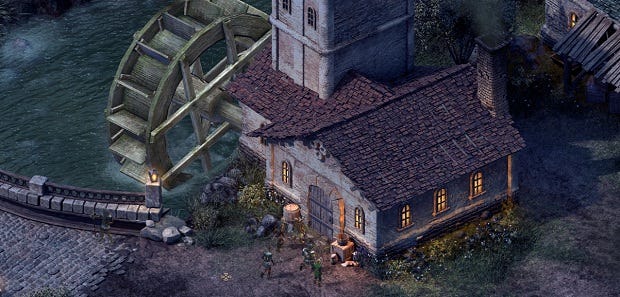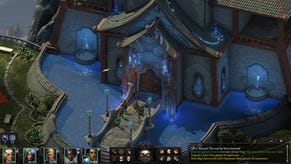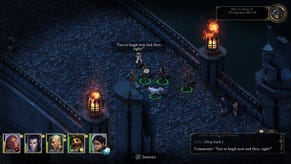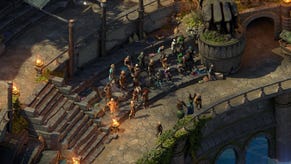Hands-On: Pillars Of Eternity
The life, death and rebirth of the party
After publishing my thorough conversation with Pillars of Eternity lead designer Josh Sawyer, I realised that I hadn’t actually expressed an opinion about the game. I was curious and hopeful but hadn’t had a chance to play it, and see how well all of the elements came together. The backer beta, which launched yesterday, is a huge relief. Pillars is shaping up to be worthy of its inspirations, and intelligent and bold enough not to be bound to them.
The backer beta (I’m not a backer but have press access) doesn’t contain spoilers for the main plotline, which is a thoughtful approach. It means that I can happily spend five hours playing – as I did last night – knowing that I won’t have to retrace my steps when the game is released. The playable area is a village, with quests that take players to spider-strewn caves and nearby wilderness areas. Party members are intentionally generic types rather than scripted characters and the player can immediately raise their level to five, allowing customisation of skills and stats.
Character creation is in place as well, with the full range of options that will be in the finished game. For my first playthrough, I rolled an actual physical die and obeyed its pips, selecting gender, race, background and class at random. I ended up inhabiting the body and mind of the little chap below and was disappointed that my inventory didn’t contain a magnificent comb to maintain the elegance of my face-fuzz.
No matter. There’s an ogre to kill and a lost noble to find. The setting and quests are fairly typical - there’s even a bard strumming by a fireside and regaling the party with local history – but we always knew that would be the case. Lead designer Josh Sawyer used the term ‘nostalgia-driven’ to describe the game when I spoke to him last month and within minutes of loading the game, the warm comforting embrace of Baldur’s Gate is evident.
Pillars does an excellent job of making the player feel as if they’re in safe hands. It’s like sliding your feet into an old pair of slippers and settling down with a freshly brewed cup of tea while somebody spins a good yarn. There’s a sedate spectacle in the creaking revolution of a watermill’s wheel and while the wilderness areas aren’t as pretty as the settlements and interiors, the world is a fine place to spend time, even as a tourist.
Dialogue is plentiful and engaging, and the whole package makes it’s very easy to feel like you’re safely cocooned in the nineties. Remember the nineties? When CRPGs contained lands of wonder and Shaun Ryder doing a swear on TFI Friday actually shocked people, who must spend half of their lives in the recovery position now that BBC newsreaders with regional accents are actively encouraged to refer to ‘breaking news’ as ‘incoming shitstorms’.
If Pillars of Eternity were nothing more than an attempt to recreate the past with a new paintjob, I’d be happy enough to play but might not be quite as curious about the end result. The Infinity engine template forms the outline for Pillars and the broad strokes are D&D-ish, but the deviation is in the details. Rather than pulling apart every alteration to the expected systems, I’m going to focus on camping, resting and healing.
It’s an integral part of the game and an aspect of adventuring that has traditionally been an afterthought or means to access a ‘quick heal’ button. Obsidian have made it part of each player’s personal narrative, by adding flavour and building a set of healing and buff mechanics around the need for rest. Checking into the beta village’s inn provides a choice of rooms, each named and some with implied backstory.
One of the rooms looks out onto a stinky workshop, which means that you’ll do little more than recover while you rest there. Other rooms, pricier rooms, provide buffs to stats, which last until the next time the party rests. That provides an incentive to utilise inns whenever the chance arises and to spend as much time between bouts of snoozing as possible. This seemingly slight change creates a tension – venturing out into the wild unknown leaves the party reliant on their limited supplies and requires intelligent management of short-term and long-term damage, as well as any abilities that are reliant on resting.
On higher difficulty levels, the limit on camping supplies is stricter and with party member permadeath enabled, Pillars is the rare RPG in which combat has consequences and mortality makes itself known.
The classes are immediately recognisable but skillsets and playstyles are very different from one to the next, which provides a variety of tactics to master, and raises the potential value of a second or third playthrough. Sawyer says the game has been designed to provide paths for any character build and reckons each should be as interesting as the next, or thereabouts. A high Might stat is as likely to open up dialogue/interactions options as a soaring Intelligence, and a clumsy wizard should be as viable a character choice as a muscular rogue.
The proof of all that will be in the pudding, of course, and the beta is little more than a spoonful of sugar. Mechanically, Pillars is close enough to an Infinity engine game to be mistaken for one, but it’s shot through with novel ideas and tweaks to the formula. The same is true of the setting, which is packed with all the usual fantasy bits and bobs, but appears to be at least aspiring to thematic coherence and interesting inventions.
As with the rest, the deviation is in the details. There may be an ogre stomping around the place but don’t presume to know exactly what ‘ogre’ means in this new world. There’s a lovely sense of rediscovery while uncovering lore and filling in the bestiary. New thoughts and histories attached to traditional types and tropes. The first time I saw the beta content, Obsidian were playing through it themselves, and a combination of overconfidence and haste left them with two maimed party members as the presentation drew to a close. Outwitted by spiders and limping toward the end of a quest, they answered my questions about permadeath and injuries while keeping some of their attention on the screen.
"What happens if the player character gets maimed? Is that a permanent injury?"
"Here, we can show you." They instructed the party's warrior to attack the leader. Evidently the spiderbites had taken their toll because the blow didn't knock her out or maim her, it killed her outright. Death of the party. I've fared somewhat better but I'm picking each class apart as I go, learning the tricks of the trade. The possibilities in battle can be slightly overwhelming at first but that's at least partly due to plunging in with a full set of characters at level 5. Less time to learn each ability as it is gained.
Nostalgia may be the initial draw, for some of the audience at least, but Pillars doesn’t map directly onto any of the Infinity engine games. The layers of interaction and intricacy of class roles are evidence of a developer comfortable with the familiar, and able and willing to flex the creative muscles where appropriate. It may be partly an exercise in nostalgia and looking backwards but, along with Original Sin and a few other potential bright spots, Pillars is making me super excited about the future of CRPGs for the first time in years.
Pillars of Eternity's backer beta is available now. It contains horrible spiders but don't hold that against it.





















